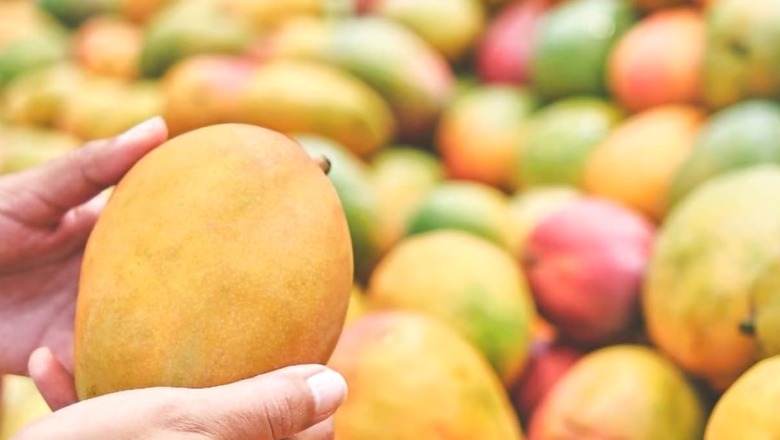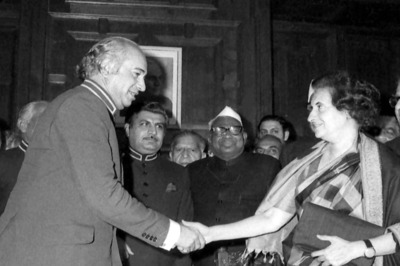
views
“Now buy Alphonso mangoes on EMI”. I saw this headline in an article in some newspaper in Pune. A mango trader is offering to sell mangoes on a monthly instalment scheme. Obviously, Alphonso and Devgad mangoes are too expensive for the common man to buy. This is why, the Ratnagiri and Devgad Alphonso (Hapus) as much as I am in love with the taste, anger me. It’s just too expensive.
I don’t know why, but we have always thought of mangoes as the prerogative and privilege of the Konkan Coast and the asset and wealth of Ratnagiri in Maharashtra. With every coming flush of the mango season, I get proven wrong.
This year, I was sent a box of ripe alphonso mangoes by a friend sometime in January. I thought to myself, this is impossible, January? But they were right in front of my eyes, ripe, golden, firm, sweet and ready to eat Alphonso mangoes. On probing, I discovered that these mangoes were Malawi mangoes, grown in Malawi, a country landlocked in southeast Africa, between Zambia and Tanzania. They smelt like Alphonso and tasted like Alphonso; they were Alphonso, but not from Ratnagiri and Devgadh.
I have travelled extensively in the mango belt of Maharashtra. I have watched the Alphonso turn from green to gold and finally luxuriate into nectar. I have wandered through shaded orchards of the creamy textured and sweet, apricot-like flavoured Ratnagiri Hapus. Relished the uniquely flavoured, watery, sweet and tangy Pairi mango, or the large Rajapuri Mango, sweet and delicious in the hot Konkan sun. Of course, these varieties often come at a fancy price by the time they reach the markets of your city. I often complain about the prices of mangoes, and on one such day, as I was bellyaching to a friend about it, she suggested I actually go to the fruit market, instead of looking for mangoes in air-conditioned food halls. So, I did. I went to ‘Bhaaji Gully’ near Grant Road Station. It’s a narrow lane of short buildings with crumbling stone facades affixed with Romanesque balusters. The non-existing pavement is crammed with sellers selling you every kind of vegetables and fruits imaginable. And the market was full of mangoes. A miscellaneousness of mangoes other than the Alphonso.
I learnt one thing. No longer does Ratnagiri rule in ‘Bhaaji Gully’, and neither does Devgadh reign supreme at BB Dadar Market. These markets traditionally sold Alphonso and Pairi, and as the season progressed, other local varieties are overrun with an explosion of mangoes of all kinds, sizes, shapes, and flavours from various parts of the country. I suppose it may also be the prices of the King of Mango exponentially reaching prohibitive proportions that may be encouraging people like us to explore more affordable varieties. For a mango lover, who is not a traditionalist and is willing to be unbiased and receptive, a whole new world of taste and flavour will open up if you dare to explore.
Flavours and tastes that come not from the West, but the East. India grows and exports more than 16 varieties of mangoes from West Bengal, and Bihar. And there are some great mangoes here. For example, from Murshidabad, West Bengal comes the Himsagar Mango, a medium-sized mango, greenish in colour with a yellow pulp. The sweetness of Himsagar mangoes is often described as intense and luscious, with floral hints and notes, like a tropical fruit. Much like the Kishan Bhog Mango from the same area which is relatively small sized mango, greenish-yellow when unripe, which turn golden yellow with slight red or orange blushes as they ripen. It’s a great mango to use in making desserts, jams, pickles, and drinks because its flesh is smooth, juicy, and fibreless, and is pleasantly sweet with subtle citrus undertones.
In June and July, the Malda district of West Bengal bears fruit to the Lakshmanbhog Mango and the Fazli Mango. The Lakshmanbhog has a gleaming golden reddish skin, with a perfectly balanced sweet flavour. The Falzi Mango is relatively larger and filled with lots of sweet pulp. Murshidabad in West Bengal used to be also known for Nawab Pasand Mango, Begum Pasand Mango, Kohitur, and Kalapahar. A variety of mangoes, which are unfortunately disappearing form the orchards and markets.
The West Bengal, Jharkhand and Bihar belt is as prolific with mangoes as is Ratnagiri, and if I start naming the mango varieties from just Bihar, you will be gobsmacked. Have you ever heard of Mallika, Zardalu, Gulabkhas, Bumbai, Daseri or Chausa? The Chausa is a fabulous fruit, sweet, juicy, and exotically aromatic. Most have neither heard about or tasted the mangoes that flourish in the state of Jharkhand. Mangoes like Langra, Bombay Green, Mithua, Gulabkhas, Zardalu, Dashehari, Sipia, Fazli, Ketki, Prabhashanker and Mahmood Bahar.
I suggest we all explore the rest of the country and this world of the Indian mangoes. For a moment forget about the Alphonso and Pairi and let’s suck it up here.
Kunal Vijayakar is a food writer based in Mumbai. He tweets @kunalvijayakar and can be followed on Instagram @kunalvijayakar. His YouTube channel is called Khaane Mein Kya Hai. The views expressed in this article are those of the author and do not represent the stand of this publication.



















Comments
0 comment